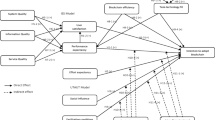Abstract
Online Q&A communities provide Internet users with an online platform for knowledge dissemination, communication and sharing. The characteristics of blockchain technology, such as untampered, traceability, and data up-chaining, can help solve the problems of knowledge privacy protection, affirming knowledge Ownership, and trust deficit faced by users when sharing knowledge in traditional online Q&A communities, and enhance users’ willingness to share knowledge on the platform. Studying users’ perceived characteristics and usage attitudes toward blockchain embedded in online platforms is important for enhancing users’ willingness to share knowledge and exploring the management mechanism of blockchain technology on online platforms. Based on the task-technology matching theory and technology acceptance model, this paper explores the impact of task-technology matching on users’ perceived characteristics and digs deeper into how users’ perceived characteristics of blockchain technology affect users’ usage attitudes and thus stimulate users’ willingness to share knowledge. Task-technology matching also positively influences users’ willingness to share knowledge by positively affecting perceived characteristics and users’ attitudes toward using. The findings of the study provide inspiration and guidance on how platforms can use new technologies to enhance users’ willingness to share knowledge.


Similar content being viewed by others
Data availability
The datasets used during the current study are available from the corresponding author upon reasonable request.
References
Li Z, Qiao G, Tang H, Wu L (2020) Blockchain technology and community knowledge sharing [J]. Sci Technol Manag Res 40(15):199–208
Yujia Li, Xiangxian Z (2017) Research on the driving mechanism of knowledge flow in academic virtual communities [J]. Intell Sci 35(03):139–143
Larimer D, Scott N, Zavgorodnev V (2016) Steem: An incentivized, blockchain-based social media platform [J]. https://steemcom/SteemWhitePaperpdf
Li C, Palanisamy B (2019) Incentivized blockchain-based social media platforms: a case study of steemit [J]. In: Proceedings of the 10th ACM conference on web science Boston: ACM, pp. 145–154
Zhang JF, Gu X (2020) Research on knowledge blockchain for distributed innovation in the perspective of blockchain technology [J]. Intell Sci 40(3):754–760
Zyskind G, Nathan O, Pentland AS (2015) Decentralizing privacy: using blockchain to protect personal data [J]. In: Security and Privacy Workshops, SPW 2015 (IEEE), pp. 180–184
Goodhue DL, Thompson RLT (1995) Task-technology fit and individual performance [J]. MIS Q 19(2):213–236
D’ambra J, Rice RE (2001) Emerging factors in user evaluation of the world wide web [J]. Inf Manag 38(6):373–384
Wells JD, Sarkers S, Urbaczewskia A (2003) Studying customer evaluations of electronic commerce applications: A review and adaptation of the task-technology fit perspective [J].In: Proceedings of the 36th Annual Hawaii International Conference on System SciencesBig Island: HICSS
Klopping IM, McKinney E (2004) Extending the technology acceptance model and the task-technology fit model to consumer e-commerce [J]. Inf Technol Learn Perform J 22(1):35–48
Chen Y, Yang BJ (2009) A review of the theoretical development of technology acceptance models [J]. Sci Technol Progr Response
Sirdeshmukh D, Singh J, Sabol B (2022) Consumer trust, value, and loyalty in relational exchange [J]. J Mark 6(1):15–37
Moons I, Pelsmacker PD (2015) An extended decomposed theory of planned behaviour to predict the usage intention of the electric car: a multi-group comparison [J]. Sustainability 7(5):212–215
Venkatraman N (1989) The concept of fit in strategy search:towards verbal and statistical correspondence [J]. Acad Manag Rev 14(3):423–444
Zheng Y, Boh WF (2021) Value drivers of blockchain technology: a case study of blockchain-enabled online community [J]. Telemat Inf 58:101563
Bhattacherjee A (2001) Understanding information systems continuance: an expectation-confirmation model [J]. MIS Q 2(3):351–370
Gan CHM, Wang WJ (2014) An empirical analysis of the impact of trust on academic bloggers’ willingness to acquire and share knowledge [J]. Intell Theory Pract 37(11):67–70
Yu D, Dong H, Liu R (2008) Current status and prospects of the theory of rational behavior and its extension [J]. Adv Psychol Sci 15(5):796–802
Ou CX, Pavlou PA, Davison R (2014) Swift guanxi in online marketplaces: the role of computer-mediated communication technologies [J]. MIS Q 38(1):209–230
Li S (2019) A study on the perceived risk of scientific data sharing in university libraries by library intelligence researchers [J]. Libr Stud 9:44–53
Jinzhao Z (2013) Research on the willingness of scientific data sharing among university researchers in China [J]. J Intell Theory Pract 10:25–30
Luo H, Rao P-L, Ji X (2017) The impact of trust and security on mobile payment decisions [J]. Bus Econ 8(444):68–72
Huang TS, Li SW, Yin XD, Xiao FA (2021) Blockchain-based algorithm for secure spectrum sensing [J]. Optoelectronics 32:1353–1358
Dishaw MT, Strong DM (1999) Extending the technology acceptance model with task-technology fit constructs [J]. Inf Manag 36(1):9–21
Leong LW, Ibrahim O, Dalvi-Esfahani M (2018) Th moderating effect of experience on the intention to adopt mobile social network sites for pedagogical purposes: an extension of the technology acceptance model [J]. Educ Inf Technol 23(6):2477–2498
Hidayanto AN, Febriawan D, Sucahyo YG (2014) Factors influencing the use of e-class [J]. J Ind Intell Inf 2(2):121–125
Mittendorf C (2017) The implications of trust in the sharing economy: an empirical analysis of uber [J]. In: Proceedings of the 50th Hawaii International Conference on System Sciences
Jian D, Jing L, Dong W et al (2013) User acceptance of software as a service: evidence from customers of China’s leading ecommerce company, Alibaba [J]. J Syst Softw 86(8):2034–2044
Moore GC, Benbasat L (1991) Development of an instrument to measure the perceptions of adopting an information technology innovation [J]. Inf Syst Res 2(3):192–222
Yang Q, Pang C, Liu L, Yen DC, Tarn JM (2015) Exploring consumer perceived risk and trust for online payments: an empirical study in China’s younger generation [J]. Comput Hum Behav 50:9–24
Patel KJ, Patel HJ (2018) Adoption of internet banking services in Gujarat: an extension of tam with perceived security and social influence [J]. Int J Bank Mark 36(1):147–169
Davis FD, Bagozzi RP, Warshaw PR (1989) User acceptance of computer technology: a comparison of two theoretical models [J]. Manag Sci 3(8):982–1003
Gefen D, Karahanna E, Straub DW (2003) Trust and TAM in online shopping: an integrated model [J]. MIS Q 27(1):51–90
Davis FD (1989) Perceived usefulness, perceived ease of use, and user acceptance of information technology [J]. MIS Q 13(3):319–340
Kankanhalli A, Tan BCY, Wei K (2005) Contributing knowledge to electronic knowledge repositories: an empirical investigation [J]. MIS Q 29(1):113–143
Funding
The author(s) received support for the National Nature Foundation, “Research on Knowledge Transmission Mechanism of Mobile Social Network wechat” (71571022, 2016.01–2019.12) in researching, writing and/or publishing this article.
Author information
Authors and Affiliations
Corresponding author
Ethics declarations
Conflict of interest
The authors declare no conflict of interest exists.
Additional information
Publisher's Note
Springer Nature remains neutral with regard to jurisdictional claims in published maps and institutional affiliations.
Rights and permissions
Springer Nature or its licensor (e.g. a society or other partner) holds exclusive rights to this article under a publishing agreement with the author(s) or other rightsholder(s); author self-archiving of the accepted manuscript version of this article is solely governed by the terms of such publishing agreement and applicable law.
About this article
Cite this article
Zhang, S., Shi, W. & Zhang, M. Blockchain-enabled Q&A communities: the impact of task technology matching on willingness to share knowledge. Neural Comput & Applic 36, 2171–2186 (2024). https://doi.org/10.1007/s00521-023-08618-6
Received:
Accepted:
Published:
Issue Date:
DOI: https://doi.org/10.1007/s00521-023-08618-6




